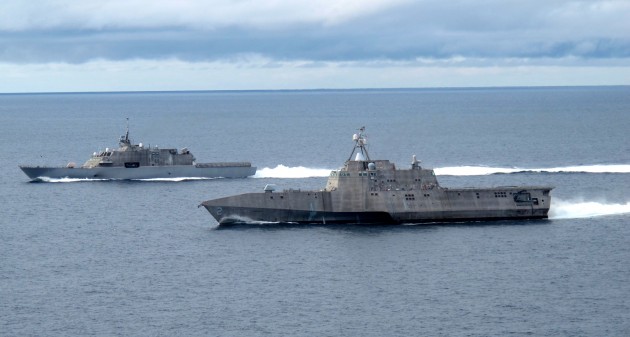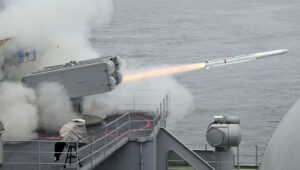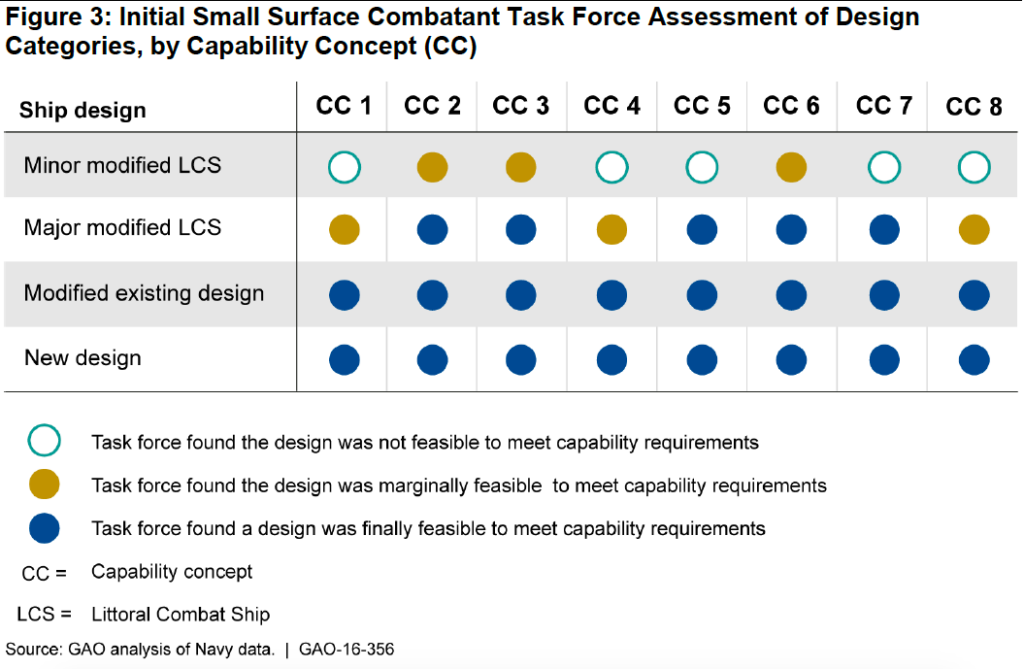
The two Littoral Combat Ship variants, LCS-1 Freedom (far) and LCS-2 Independence (near).
WASHINGTON: The upgraded frigate variant of the Littoral Combat Ship isn’t much of an improvement over the controversial original, the Government Accountability Office says, because the Navy was too focused on keeping costs down and production lines humming. But even if you agree with GAO, given how much pressure the Navy is under to grow the fleet without growing the budget, you can’t really blame them.
“The Navy prioritized cost and schedule considerations over the fact that a minor modified LCS” — what’s now called the frigate — “was the least capable option considered,” GAO writes in its report, out late Thursday.
In its haste, says GAO, the Navy plans to commit to frigate contracts before the detailed design is even complete, which means cost estimates involve a lot more guesswork about what the ship will actually be like. Contracting on the basis of rough designs is a common Navy practice to avoid program delays, admittedly, but it’s also a common source of overruns.
GAO argues the shipyards have plenty of original-LCS work to keep them in business through 2017, so the Navy should stop buying LCS in ’17, pausing the program for a year, and meanwhile come up with a more rigorous acquisition strategy for the frigate. (GAO pretty much always recommends more rigor). That revised strategy should include outside review by the Joint Staff and the Cost Assessment & Program Evaluation (CAPE) shop in the Office of Secretary of Defense (OSD) to determine whether the Navy is really buying the best ship.

Evolved Sea Sparrow Missile (ESSM) launching
Air Defense & Other Tradeoffs
What opportunities did the Navy miss that more money, or more time, might have allowed? When the Small Surface Combatant Task Force (SSCTF) focus-grouped alternative designs with officers from both the Atlantic and Pacific fleets, GAO reports, these experienced operators really, really wanted more capability to shoot down incoming aircraft and cruise missiles. Specifically they wanted “local” Anti-Air Warfare (AAW), the capacity for a ship to protect not just itself (self-defense AAW) but other vessels nearby, for example an aircraft carrier or unarmed supply ships it was escorting. But the task force kept forcing tighter and tighter cost caps on the hypothetical ship design, until the officers in the exercise couldn’t afford such an expensive system.
The frigate design the Navy chose, instead, has the same modest, purely self-defensive anti-aircraft capability as the original LCS. The frigate’s focus is on other missions. It combines the Anti-Submarine Warfare (ASW) and Anti-Surface Ship Warfare (ASUW) capabilities of two different configurations of the original LCS, which can only carry the equipment for one or the other at any given time. (The original LCS carries mission modules, so commanders can kit it out for either ASW or ASUW or mine-clearing, which last the frigate can’t do).
The frigate also has modest improvements to anti-missile countermeasures and armor that GAO doesn’t consider significant. To accommodate these additional capabilities, GAO says the frigate gives up some carrying capacity for small boats — used for boarding and security patrols — and some of its (very high) speed and (already limited) range. Range is arguably the most worrisome tradeoff in the vast Pacific.
Overall, the task force had started out considering a wide range of alternatives, from “minor” modifications to the existing LCS, to a lengthened LCS with more capacity, to variants of other available vessels like the Coast Guard’s National Security Cutter, to an all-new design. The “minor modified LCS,” unsurprisingly, offered the fewest improvements but the lowest cost — and, unsurprisingly, the whole Navy process pressed for it. Even when the task force reported the minor-modifications option couldn’t accommodate the chosen capabilities, GAO says, their Navy overseers told them to reexamine the capabilities to see how much they could fit.

GAO’s comparison of the Navy’s eight concepts for upgraded LCS capabilities (CC1-CC8) and the four types of ships to install them on.
On the cost comparison, GAO argues the Navy put its thumb on the scales by overestimating crew size, and thus long-term manpower cost, for the alternatives to the minor-modified LCS. Otherwise, however, the Navy’s costing methodology seems sound. And it’s hard to argue with the proposition that a modestly modified upgrade of a ship the Navy’s already buying is going to cost less than a major modification, a Navy variant of someone else’s ship, or an all-new design.
While Navy shipbuilding has done well in the budget battles of the last few years, it remains under intense fiscal pressure. Meanwhile, the fleet is under intense strategic pressure to cover a wide range of deployments worldwide, keeping up a pace so intense that it’s wearing out ships and crews alike. The only way to get more ships at sea without a lot more money is to buy cheap ships — which is why the Navy is sticking with modestly upgraded models of LCS.
Multi-ship amphib buy could net $900M in savings, say Navy, Marine Corps officials
Lawmakers gave the Navy authorities to ink a multi-ship amphib deal years ago, but the service has not utilized that power yet.


























